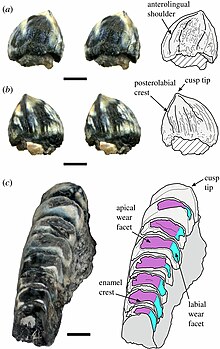Eilenodontinae
 From Wikipedia the free encyclopedia
From Wikipedia the free encyclopedia
| Eilenodontinae Temporal range: | |
|---|---|
 | |
| Skeleton of Priosphenodon avelasi | |
 | |
| Teeth and jaws of Eilenodon | |
| Scientific classification | |
| Domain: | Eukaryota |
| Kingdom: | Animalia |
| Phylum: | Chordata |
| Class: | Reptilia |
| Order: | Rhynchocephalia |
| Suborder: | Sphenodontia |
| Subfamily: | †Eilenodontinae Rasmussen and Callison 1981 |
| Genera | |
Eilenodontinae are an extinct clade of reptiles belonging to Sphenodontia. They are either considered a subgroup of Opisthodontia,[1] or Sphenodontidae.[2] They had deep jaws with broad, closely packed teeth with thick enamel and noticeable wear facets. They were likely herbivorous, and probably chewed with a proal (forward stroke) movement, with food shredded between the edges of opposing sharp-edged wear facets. Members of the group are known from South America, North America and Europe.[3] The earliest known member of the group, Sphenotitan, is known from the Late Triassic of South America.[2] while the youngest members are known from the Late Cretaceous of South America.[4] The group contains some of the largest known sphenodontians, with Priosphenodon suggested to be the largest known non aquatic sphenodontian, with an estimated body length of over 1 metre (3.3 ft).[5]
References
[edit]- ^ Romo de Vivar, Paulo R.; Martinelli, Agustín G.; Schmaltz Hsiou, Annie; Soares, Marina Bento (2020-07-02). "A New Rhynchocephalian from the Late Triassic of Southern Brazil Enhances Eusphenodontian Diversity". Journal of Systematic Palaeontology. 18 (13): 1103–1126. doi:10.1080/14772019.2020.1732488. ISSN 1477-2019. S2CID 216226211.
- ^ a b Simões, Tiago R.; Kinney-Broderick, Grace; Pierce, Stephanie E. (2022-03-03). "An exceptionally preserved Sphenodon-like sphenodontian reveals deep time conservation of the tuatara skeleton and ontogeny". Communications Biology. 5 (1): 195. doi:10.1038/s42003-022-03144-y. ISSN 2399-3642. PMC 8894340. PMID 35241764.
- ^ Jones, Marc E. H.; Lucas, Peter W.; Tucker, Abigail S.; Watson, Amy P.; Sertich, Joseph J. W.; Foster, John R.; Williams, Ruth; Garbe, Ulf; Bevitt, Joseph J.; Salvemini, Floriana (June 2018). "Neutron scanning reveals unexpected complexity in the enamel thickness of an herbivorous Jurassic reptile". Journal of the Royal Society Interface. 15 (143): 20180039. doi:10.1098/rsif.2018.0039. ISSN 1742-5689. PMC 6030635. PMID 29899156.
- ^ Gentil, Adriel R.; Agnolin, Federico L.; Garcia Marsà, Jordi A.; Motta, Matias J.; Novas, Fernando E. (June 2019). "Bridging the gap: Sphenodont remains from the Turonian (Upper Cretaceous) of Patagonia. Palaeobiological inferences". Cretaceous Research. 98: 72–83. doi:10.1016/j.cretres.2019.01.016. S2CID 135429146.
- ^ Apesteguía, Sebastián; Novas, Fernando E. (9 October 2003). "Large Cretaceous sphenodontian from Patagonia provides insight into lepidosaur evolution in Gondwana". Nature. 425 (6958): 609–612. Bibcode:2003Natur.425..609A. doi:10.1038/nature01995. PMID 14534584. S2CID 4425130.